Christmas at the Court of King James I
by Elaine Walker
King James I became the first monarch to rule the whole of the
British Isles with the death of his cousin, Elizabeth I, in 1603.
He had been on the throne for only six months when he hosted his
first Christmas and New Year festivities. The celebrations
offered an opportunity to display his wealth and largesse, with
extensive feasting, dancing and theatrical performances in the
Great Hall of Hampton Court Palace. Among the actors was one
William Shakespeare, whose play A Midsummer Night's Dream
is thought to have been performed on New Year's Day, under the
title A Play of Robin Goodfellow. The whole week would
have been full of colour and inventive entertainment, helping to
establish King James as a gracious and regal host and setting the
pattern for Christmas throughout his reign.
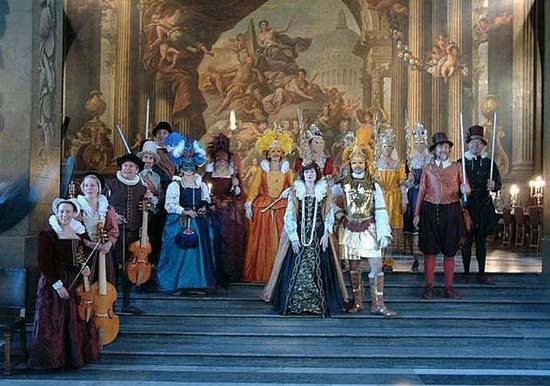
The King's lavish generosity at Hampton Court was part of his
belief in the value of traditional customs, and extended to his
whole household in a measure considered suitable to their status.
He believed that 'certaine dayes in the yeere should be
appointed, for delighting the people, for conveening of
neighbours, for entertaining friendship and heartlinesse, by
honest feasting and merrinesse'. At Christmas, this included the
duty of the wealthy to succour the poor, and the King ensured
that this continued by writing the custom of hospitality on St.
Stephen's Day (Boxing Day) into the law.
Shakespeare's King Lear, which was performed for King
James on St. Stephen's Day in 1606, is full of references to the
care of the homeless on this day. A popular saying reminded
people that 'Blessed be St. Stephen/There's no fast upon his
even'. Shakespeare recalled another favourite Christmas festival
in Twelfth Night, which was performed before King James in
1618 and 1623. The play centres around generosity, love and
change in the disguises, mistaken identities and happy outcomes
for all but the gloomy Malvolio. Malvolio represents the growing
Puritan suspicion of celebratory festivals, especially Christmas,
and the riotous Sir Toby Belch addresses the matter when he asks
Malvolio, 'Dost thou think because thou art virtuous, there shall
be no more cakes and ale?'.
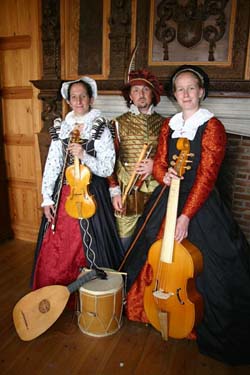 Another popular feature of
Christmas festivities was the Feast of Fools from St. Stephen's
Day until December 28th. This period reminded the Christmas
revellers of the Christian message of hope for the poor and weak,
but was rooted in the pagan tradition of the Lord of Misrule.
Society turned briefly on its head, so that kings could become
fools and fools could become kings. Masques, which King James
particularly enjoyed, developed from this festival of drinking,
games and disorder. Masques were short dramatic entertainments
with music, verse, dancing and elaborate scenic effects and
flourished at court in King James' time. Ladies and gentlemen,
including members of the royal family, appeared in the masques,
along with professional actors. The masques were often written
for a specific event at which the king was to be present, and so
included declarations of love and loyalty addressed directly to
him on behalf of his subjects. Another popular feature of
Christmas festivities was the Feast of Fools from St. Stephen's
Day until December 28th. This period reminded the Christmas
revellers of the Christian message of hope for the poor and weak,
but was rooted in the pagan tradition of the Lord of Misrule.
Society turned briefly on its head, so that kings could become
fools and fools could become kings. Masques, which King James
particularly enjoyed, developed from this festival of drinking,
games and disorder. Masques were short dramatic entertainments
with music, verse, dancing and elaborate scenic effects and
flourished at court in King James' time. Ladies and gentlemen,
including members of the royal family, appeared in the masques,
along with professional actors. The masques were often written
for a specific event at which the king was to be present, and so
included declarations of love and loyalty addressed directly to
him on behalf of his subjects.
On Twelfth Night in 1607, a masque by Thomas Campion was held at
the Palace of Whitehall in the presence of King James and
detailed notes of the event give an idea of how elaborate these
theatrical performances were. The Great Hall of the palace had
seats on either side with scaffolding for two stages, the lower
one being for dancing. Twenty musicians were involved with lutes,
a bandora, a sackbut, a harpsichord and violins, as well as
singers. The scenery included a double veil, painted to look like
dark clouds over a green valley with nine golden trees, whose
branches were 'very glorious to behold'. At the sides of the
stage, the scenery suggested two hills with decorated bowers for
the characters Flora and Night and a tree belonging to Diana, the
goddess of the Hunt. The set included details such as
'artificialle Battes and Owles on wyer constantly moving'. When
the King arrived, the musicians played until he and his entourage
were settled, then after a 'little time of expectation', the
masque began, with much singing and dancing.
Ben Jonson's Christmas His Masque was written and
performed for King James and Queen Anne in 1616. Early in the
masque, the characters offer prayers for the royal couple's
welfare and pray they will like the performance, for 'If not, old
Christmas is undone'. This placing of the future of Christmas in
the hands of the monarch was prophetic as Christmas festivities
were banned in 1647, after Charles I lost his throne to
Parliament, and not reinstated until the Restoration of the
monarchy in 1660. The ill-fated future king was a young boy in
1616 and is mentioned in Jonson's masque as 'Your highness
small'.
The focus on family, the love of the people for the King and the
celebration of traditional customs are at the heart of Jonson's
masque. The character of Christmas introduces his children, who
include 'Carol', 'Misrule', 'Wassail', 'Gambol' and 'New Year's
Gift'. At this time, gifts were given at New Year rather than
Christmas and each of Christmas's children remind the King and
the audience of the pleasures of the season. What is clear
throughout this masque, however, is the concern that these
traditions are fading away. In his Survey of London in
1603, John Stoye wrote that 'in the feast of Christmas' there
were once 'fine and subtle disguisings, masks and mummeries' and
'every man's house was decked with whatsoever the season of the
year afforded to be green'. While both festivities and decorating
houses with evergreen were still common, Stoye felt that real
enthusiasm for Christmas traditions belonged in the past.
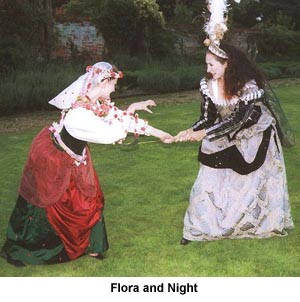 King James,
however, seems to have worked hard to keep them alive at his
court with great feasting and entertainment offered to fend off
the gloom of those who saw Christmas as a time of idolatry and
impious drunkenness. The King's court enjoyed the generous flow
of wine and ale, as well as imported spirits such as brandy and
rum, which were becoming popular amongst those who could afford
them. Christmas ale and mulled wine were also popular with the
people as well as the nobility, to be drunk hot and heavily
spiced. King James,
however, seems to have worked hard to keep them alive at his
court with great feasting and entertainment offered to fend off
the gloom of those who saw Christmas as a time of idolatry and
impious drunkenness. The King's court enjoyed the generous flow
of wine and ale, as well as imported spirits such as brandy and
rum, which were becoming popular amongst those who could afford
them. Christmas ale and mulled wine were also popular with the
people as well as the nobility, to be drunk hot and heavily
spiced.
The food enjoyed at Christmas would have included roast turkey,
goose, game birds and, at court, peacock gilded and served in its
own feathers. Other meats were also popular, with Scotch Collops
being a favourite. 'Collops' were thin slices of meat dipped in
seasoned flour then fried quickly before being immersed in a
richly flavoured casserole with wine, garlic, onions, mushrooms
and anchovies. In Scotland venison was popular in collops, while
southerners preferred ham or bacon. As in many dishes, local
tastes and the available meats decided the precise recipe.
The medieval tradition of the roast Boar's Head was still
popular as a centre-piece for Christmas Day, Twelfth Night or
both, to be carried aloft into the banqueting hall accompanied by
a fanfare of trumpets. Spit-roasting was the usual method for
cooking meat, with complex arrangements for large gatherings,
whereby a number of items could be cooked at once. The spit was
turned with a mechanical jack, wound up with a heavy weight on a
cord wrapped around a drum. As the weight gradually descended,
controlled by a balance wheel, the spit laden with meat or
poultry could be kept revolving for almost half an hour. The
development of the chimney crane, which could raise and lower the
level of pots and cauldrons over the fire, further simplified the
life of the kitchen, a place of great activity at the court.
Plum Pottage was well established by the time of King James, and
on its way to becoming the Christmas pudding of today. It had
begun as a thick soup-like dish of boiled beef or mutton with
dried fruit and plenty of spices. During the seventeenth century
it became a solid pudding without any meat, which eventually
replaced the pottage. Fats, dried fruit and sugars were notable
in this sort of heavy steamed pudding, perhaps because the damp
British climate needed good energy-producing food to keep out the
chill. 'Cambridge' or 'College' pudding, made with suet,
breadcrumbs, flour, dried fruit and eggs typified the sort of
filling dessert that made a foreign visitor declare, 'Ah what an
excellent thing is the English pudding! To come in pudding-time,
is to come in the most lucky moment in the world!' Among these
robust puddings at Christmas were 'shred' or 'mince' pies, still
popular today, which like plum pudding, originally contained both
fruit and minced meat.
Lighter sweet dishes were also popular with the refined court
diners and would have been presented very beautifully for the
King's table. These were rich, based around fruit or sugar, with
exotic fruits like pineapples and bananas beginning to make an
appearance. White Biscuit Bread, flavoured with almonds, lemon,
coriander and aniseed, were very similar to today's meringues,
and this sort of crisp delicacy was a court favourite.
'Scillybub', 'raspbery creame', and white-pot, an ancestor of
bread-and-butter pudding, all featured on the table, with an
emphasis on indulgent ingredients, with plenty of eggs and cream.
All of these dishes and many more made their appearance
at Christmas and New Year in the court celebrations of King James
I. The generosity of the monarch showed both that he could be
lavish with his subjects and that he had the wealth to entertain
them so freely. As with many of the Christmas traditions,
open-handed giving, charity, welcoming the homeless and offering
alms to the poor both broke down and reinforced social boundaries
in the same moment.
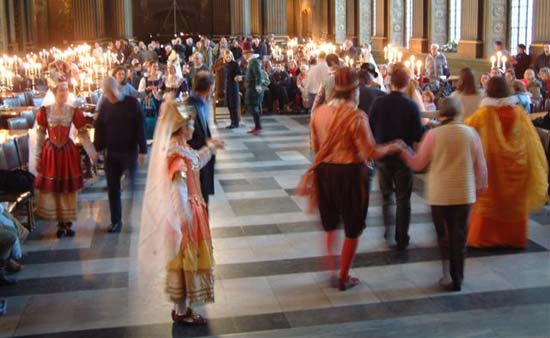
With so much feasting, the dancing must have provided a
welcome activity and Queen Anne was known for her enjoyment of
the dance floor. Dancing at court or as part of the Christmas
celebrations was not new and while the Queen was criticised by
some for her love of such pleasures, she would have understood
very well the political importance of these events. Her
willingness to take part with grace and enjoyment was part of the
welcome offered to foreign ambassadors, as well as a sign of the
royal appreciation of the court which supported the role of the
monarch. The delicate relationships of the court could be
nurtured through the King's largesse during events such as
Christmas, so as well as the sentiments of the season, some
astute political balancing would undoubtedly be going on too.
While the Jacobean Christmas was poised on the edge of a time of
great uncertainty and change, the sense of celebration and the
hopes of the new Stuart dynasty were still high during King
James' reign. So, despite concerns over the growing religious
controversies that would eventually split the kingdom, Christmas
still held an important place as a time of celebration,
hospitality and community spirit. Some of the medieval traditions
were slipping away, but decking the halls with evergreens,
sharing fine food and drink, and enjoying music and dancing still
offered the opportunity to celebrate an important Christian
festival. There was a sense of abandoning cares for a short time
which is embraced in the sentiments of a popular song which
declared,
Though some churls at our mirth repine,
Round your foreheads garlands twine,
Drown sorrow in a cup of
wine,
And let us all be merry
More Information:
We regret that we no longer have the resources to maintain up-to-date links and/or hours and pricing details for the various sites and attractions listed on this website. For more information about the location(s) listed above, please use your favorite search engine or visit Wikipedia.
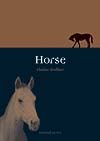 |
Dr. Elaine Walker is a freelance writer based in North Wales. She writes fiction, poetry and nonfiction and lectures in Creative Writing and English for the University of Wales. Her first full-length book, Horse, is forthcoming from Reaktion Books in Autumn 2008.
|
Article © 2005 Elaine Walker
Photos courtesy of Passomezzo.
|
